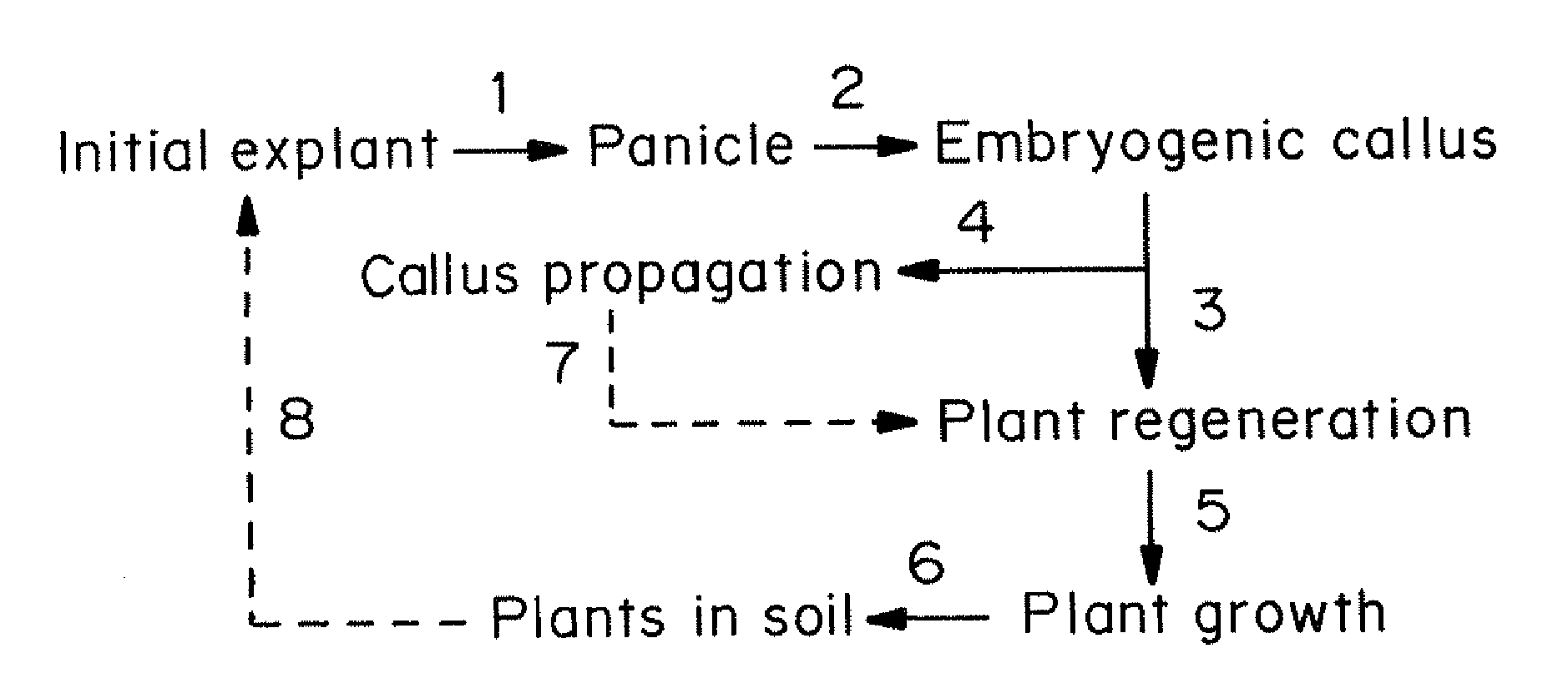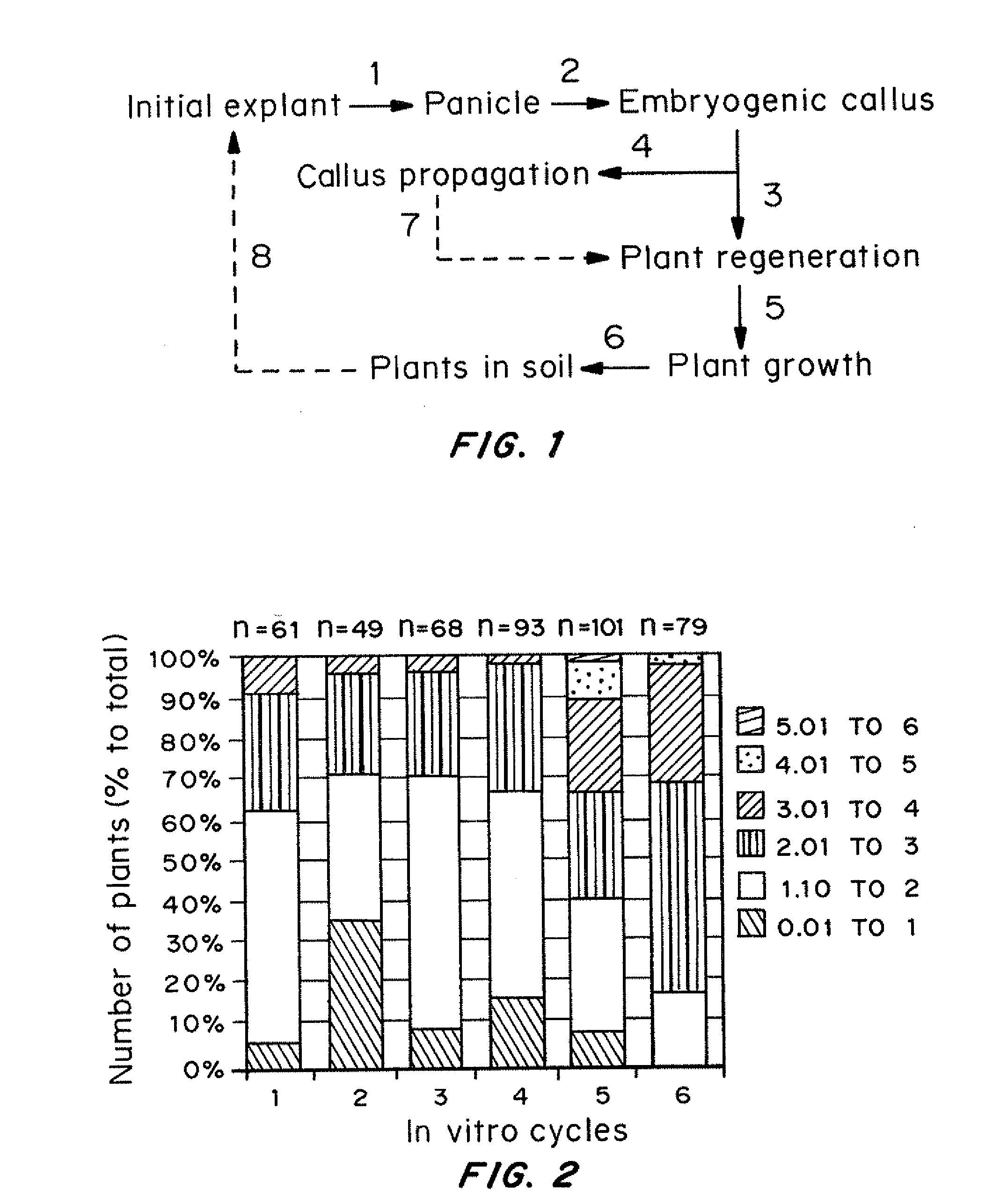Propagation of transgenic plants
a technology of transgenic plants and plant tissue, applied in the field of transgenic plant propagation, can solve the problems of difficult to achieve, limited options for traditional plant breeding methods, and a long time-consuming process for traditional plant breeding, so as to improve the characteristics of plants, increase the production of products, and increase the biomass
- Summary
- Abstract
- Description
- Claims
- Application Information
AI Technical Summary
Benefits of technology
Problems solved by technology
Method used
Image
Examples
example 1
Transformation of Switchgrass with Multi-Gene Constructs for PHB Synthesis
[0138]Multi-Gene Constructs.
[0139]pMBXS159. This binary vector contains expression cassettes for the three gene PHB biosynthetic pathway under the control of the rice polyubiquitin 2 (rubi2) promoter (Wang et al., 2000). The PHB genes chosen for this construct include a hybrid Pseudomonas oleovorans / Zoogloea ramigera PHA synthase (Huisman et al., 2001) and the thiolase and reductase from Ralstonia eutropha (Peoples and Sinskey, 1989). Each PHA gene is fused to a plastid targeting sequence encoding the signal peptide of the small subunit of Rubisco from pea and the first 24 amino acids of the mature protein (Cashmore, 1983) as previously described (Kourtz et al., 2005). Plasmid pMBXS159 was constructed using the following multi-step procedure.
[0140]i. pMBXS124, pMBXS125, and pMBXS126. These plasmids contain rubi2 and the 3′ termination sequence of nopaline synthase (nos) and differ with respect to the restricti...
example 2
Plant Regeneration from In Vitro Cultures Initiated from Transgenic Switchgrass Plants
[0150]Immature Inflorescence-Derived Embryogenic Callus Cultures.
[0151]Callus cultures were initiated from individual spikelets of in vitro developed panicles. Resultant embryogenic callus cultures were propagated by monthly transfers on to a fresh medium. At each subculture (in vitro cycle), pre-weighed callus pieces were plated on MS medium for plant regeneration.
[0152]Node Cultures.
[0153]Plants were obtained from in vitro cultured nodal segments from transgenic PHB producing switchgrass plants.
[0154]Results
[0155]The major steps of the general procedure for initiation of in vitro cultures from immature inflorescences and plant regeneration from them are shown in FIG. 1. Highly embryogenic calluses were formed from individual spikelets from panicles developed under in vitro conditions 4-6 weeks after culture initiation.
[0156]The first signs of plant regeneration were visible within 7-10 days after...
example 3
Generation of Transgenic Switchgrass Plants with Increased PHB Levels
[0160]In vitro cultures were initiated from developing panicles or nodal segments from the following types of polymer producing plants: i / primary transformants; ii / plants micropropagated from them, and iii / plants obtained from immature inflorescence-derived callus or node cultures from micropropagated plants. Transgenic lines, carrying the PHB pathway genes under the control of the maize cab-m5 promoter (Somleva et al., 2008) were used as a starting material in these experiments. PHB production in most of these T0 plants has been monitored at different stages of their growth and development under in vitro and greenhouse conditions. Plants with high, medium, and low polymer content in tissue culture or soil were included in this study.
[0161]Different approaches were used to evaluate the presence and expression of the transgenes in freshly initiated cultures and plants regenerated from them: 1 / callus growth in the ...
PUM
 Login to View More
Login to View More Abstract
Description
Claims
Application Information
 Login to View More
Login to View More - R&D
- Intellectual Property
- Life Sciences
- Materials
- Tech Scout
- Unparalleled Data Quality
- Higher Quality Content
- 60% Fewer Hallucinations
Browse by: Latest US Patents, China's latest patents, Technical Efficacy Thesaurus, Application Domain, Technology Topic, Popular Technical Reports.
© 2025 PatSnap. All rights reserved.Legal|Privacy policy|Modern Slavery Act Transparency Statement|Sitemap|About US| Contact US: help@patsnap.com



